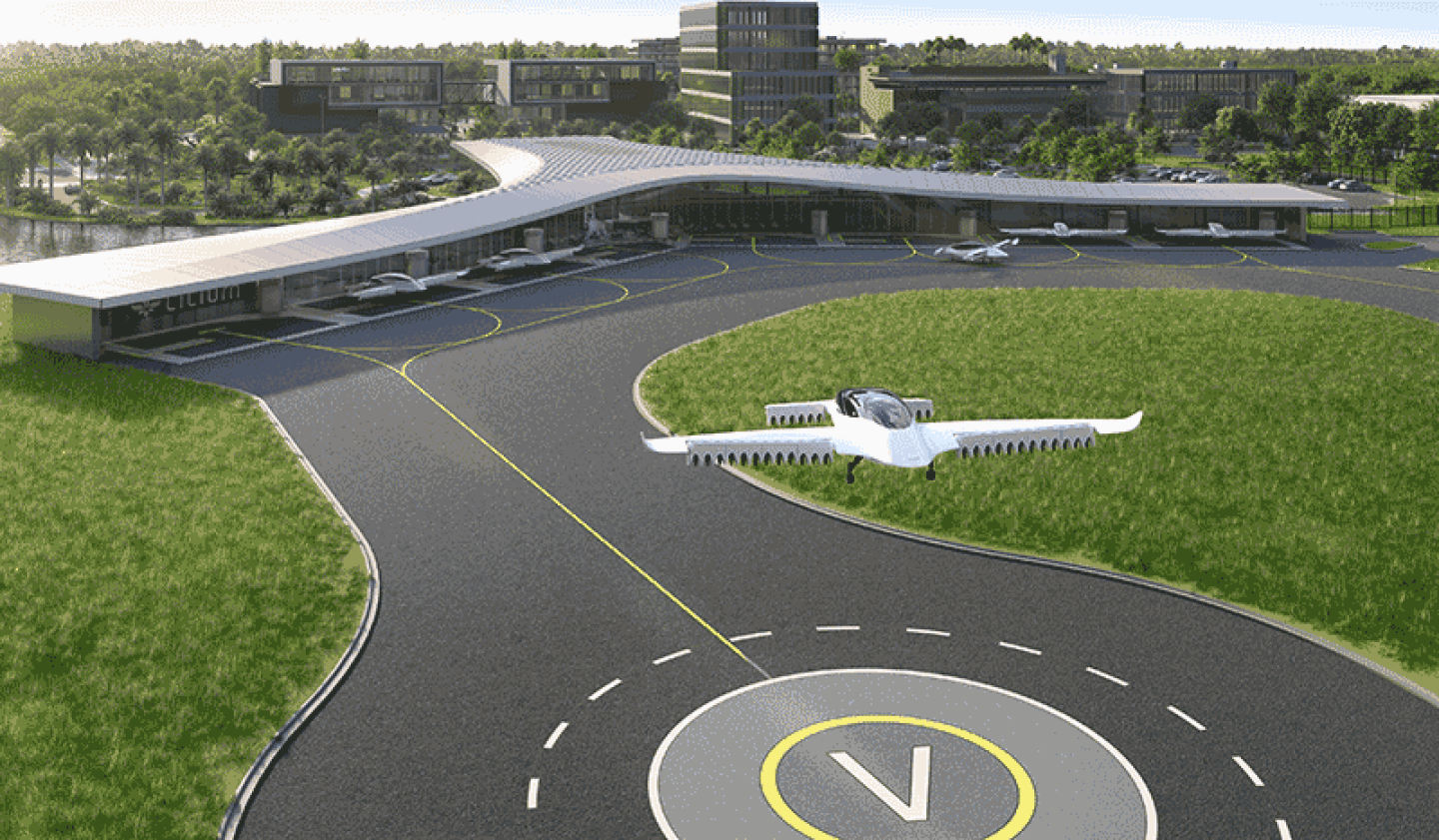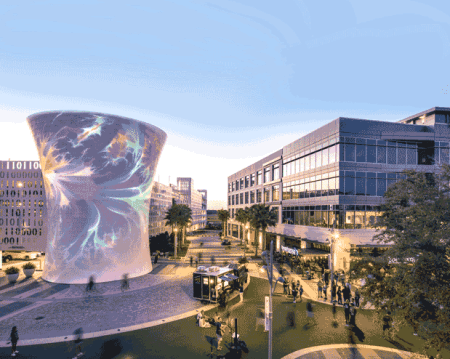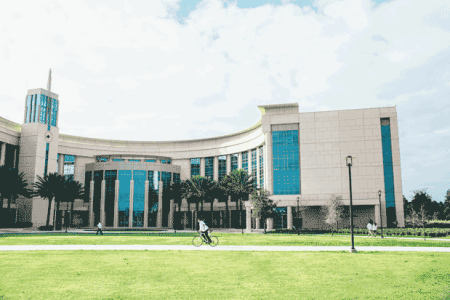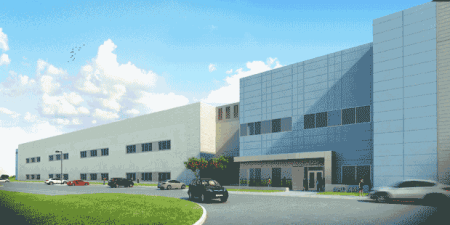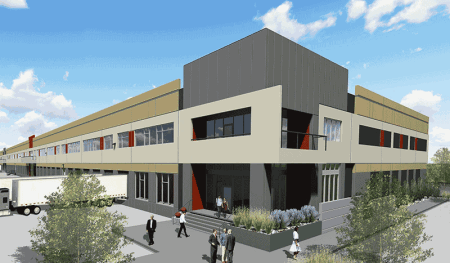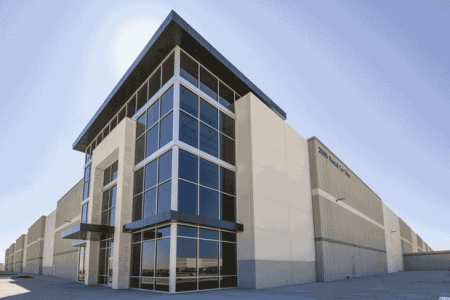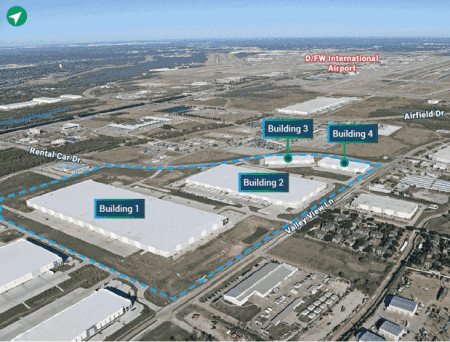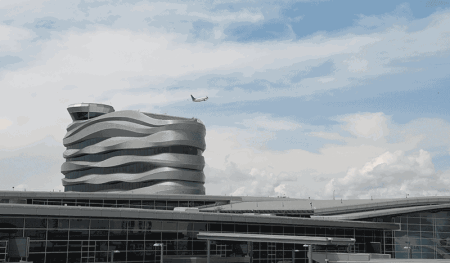Major airports have long been hubs for commercial real estate development, both on their own unused acreage and in surrounding communities. Increasingly, airport complexes are driving economic growth and business innovation as well. The logistics boom is only one factor behind their heady growth.
Situated along the eastern and southern edges of Orlando International Airport, the mixed-use master-planned community of Lake Nona in Orlando exemplifies both the diversity and the continuing evolution of airport-centric real estate development.
Lake Nona’s 17 square miles (44 sq km) of land is home to 20,000 residents as well as a sprawling complex of hospitals and health research facilities known as Medical City, and the U.S. Tennis Association’s state-of-the-art national campus, which includes 64 acres (26 ha) with 100 tennis courts where professional, collegiate, and amateur players work on their serves and backhands.
Global business services firm KPMG operates an 800,000-square-foot (74,000 sq m) professional development center as well, and SIMCOM, a company that provides simulator training to pilots, is investing $109 million in a new headquarters and training facility scheduled to open in 2022. There also is a three-year-old, 850,000-square-foot (79,000 sq m) Amazon fulfillment center, where as many as 2,500 employees work with sophisticated robots to retrieve packages and prepare them for shipment.
And if all that is not cutting-edge enough, Lake Nona is slated to be the initial U.S. hub for German aviation firm Lilium’s electric-powered vertical takeoff-and-landing aircraft. When that facility opens in 2025, it will provide air taxi service within a 186-mile (299 km) radius.
It all adds up to what Ben Weaver calls “a thriving comprehensive aerotropolis,” the term for airport-centric development. Weaver is the managing director of the Tavistock Group, whose development subsidiary started amassing land in the area when it bought a local country club during the 1990s. Back then, “we didn’t have an aerotropolis in mind,” he says.
But in recent years, Orlando International Airport’s phenomenal growth—it is now the eighth-busiest airport in the United States, with 21.6 million passengers a year—has helped turn Lake Nona into a lucrative opportunity to create the aviation-oriented community of the future, one whose anchor is an airport instead of an urban downtown.
“If I drive to the airport from my office in Lake Nona, it takes me less than 10 minutes,” Weaver says. “That’s a terrific opportunity.”
Orlando is one of numerous spots around the United States and the world where airports, once viewed simply as assets for local economies, have increasingly become cores that are driving development. In some places, airports are turning large, unused tracts of land once reserved for airport expansion into commercial real estate opportunities. In other places, private land is being turned into mixed-use communities such as Lake Nona, which capitalize on their easy access to airports.
At the same time, the land uses have evolved in response to shifts in the economy, with airports and the land around them attracting uses as varied as e-commerce and cold-storage facilities, data centers, hotels, movie studios, casinos, and medical cannabis farms.
How the Pandemic Accelerated Change
While the pandemic severely hindered travel and pummeled the airline industry, airports in some ways became even more important as economic drivers, thanks to the surge in e-commerce and demand for logistical space to handle the vast amounts of merchandise being ordered by consumers who were unwilling or unable to shop in person.
“Every crisis leads to opportunity, and some will include long-distance connectivity,” explains John Kasarda, coauthor with Greg Lindsay of the 2011 book Aerotropolis: The Way We’ll Live Next and a longtime international consultant who is a member of ULI’s Key Leaders program.
“We’re seeing cargo flights and distribution centers near airports to handle time-critical, high-value products,” Kasarda says. “And people involved in B2B businesses need to fly and meet face to face to get the process started.”
And even though the shutdown of offices and the difficulty of travel during the pandemic led to increased reliance on Zoom and other videoconferencing platforms, Kasarda predicts that that trend eventually will stimulate, rather than replace, business travel. “Remember that when the telephone was invented, Alexander Graham Bell’s first words were, ‘Watson, come here, I want you,’” he says. “Every advance in communications eventually has led to further and faster movement of people.”
Amsterdam Airport Schiphol
Kasarda notes that airport-centric development first caught on in Europe and Asia, where prototypes for massive aerotropolises have continued to grow and diversify. Amsterdam Airport Schiphol, which he calls “the grandaddy of airport cities,” began to market itself as a development anchor back in the 1990s. Today, the Schiphol Central Business District includes hotels, conference facilities, retail space, dining uses, office buildings occupied by companies such as Microsoft, several art galleries, and a casino. On the periphery, the Schiphol Area Development Company (SADC), a public/private partnership, markets an array of business and logistics parks.
Incheon International Airport
Similarly, in South Korea, Incheon International Airport near Seoul became a core for development, including office buildings, hotels, resorts, and logistics facilities on its property, with different sections connected by maglev rail. There is even more development in the 80-square-mile (209 sq km) Incheon Free Economic Zone, which attracted US$40 billion in investment in goods handling and business services between 2010 and 2020, according to Kasarda.
Incheon is in the midst of an expansion project that will increase the airport’s capacity to 160 million passengers and 6.3 million tons (5.7 metric tonnes) of cargo annually. In addition, it is working to attract large distribution centers to respond to the dramatic growth of global e-commerce, and to develop other land uses ranging from aviation support facilities to biotechnology—“an industrial ecosystem in which Incheon Airport and the industries can mutually benefit each other,” according to Jun-gi Kim, an assistant manager of Incheon International Airport Corporation.
Airports in the United States and Canada have been rapidly catching up and capitalizing on shifts in the economy and land use. The explosive growth of the internet, for example, has made tracts of unused airport land a desirable location for massive data centers, where companies can rent space to house their racks of computer servers.
Dulles International Airport
At Dulles International Airport in suburban Virginia near Washington, D.C., the Washington Metropolitan Airports Authority in 2018 sold a 424-acre (172 ha) tract to Digital Realty, a global data center developer, for $236.5 million. Digital Realty operates data centers close to major airports in other metropolitan areas, but Digital Dulles is the first facility that it will develop on former airport land.
The ample space enables the company to build a facility with enough space to accommodate a range of customers, from smaller clients’ single cabinets of servers all the way up to massive configurations that consume multiple megawatts of electricity. In addition, “being very close to the airport will make it more efficient for suppliers to support their clients within our facilities,” says Jim Zografos, Digital Realty’s senior director for portfolio management.
Buddy Rizer, executive director of economic development for Loudoun County, Virginia, one of two counties in which the airport is located, says the deal provided funding to help the airport reduce debt and keep airport fees under control. The new data center also could generate $20 million a year in tax revenue for Loudoun County, where it will be built. “Data centers are big buildings, industrial in scope, so the airport areas make a lot of sense,” notes Rizer, who says he has been approached by a major airport in another region that is seeking to make a similar deal.
“As airports look to monetize excess landholdings, many are looking to industrial development projects,” says Brian Carroll, a senior vice president for JLL in Chicago. “These projects are increasingly lucrative as that market continues to outperform other CRE [commercial real estate] sectors.”
Denver International Airport
Stretching across 34,000 acres (14,000 ha), Denver International Airport has the biggest landholdings of any airport in the United States. “We have 16,000 acres [6,500 ha] that we can use for commercial development,” says senior vice president Ken Cope, who heads a six-person department dedicated to that purpose.
The airport’s first big project was a 519-room Westin hotel and conference center that opened in 2015, with a connected transit center that links the airport to downtown Denver via commuter rail. More recently, the airport unveiled an ambitious long-term development plan, created with the help of design firm Sasaki and other contributors, which envisions multiple districts on airport land—a 360-acre (145 ha) innovation campus for technology, renewable energy, and agribusiness companies; a global business hub with 2.5 million square feet (232,000 sq m) of hospitality, conference, and office space; a hotel, restaurant, and services district; and a fourth district primarily dedicated to entertainment and retail uses. “Most of that development is focused upon what is our driveway into the airport, Pena Boulevard,” Cope says.
The Rise of Logistics
In the meantime, land around the airport is already undergoing a different sort of transformation, thanks to the increasing demand for logistics facilities. “The industrial market is growing gangbusters right now,” says Tyler Smith, managing director for Cushman & Wakefield in Denver.
One of the major players is J.A. Green, a development firm that has built warehouses near airports in Houston, Seattle, and other cities. The outfit acquired 250 acres (101 ha) of private land adjacent to Denver’s airport to develop JAG Logistics Center @ DEN, a four-building complex that will contain 3.5 million square feet (325,000 sq m) of warehouse space. Dan Green, the company’s CEO and co–managing partner, says that the initial warehouse, which was completed in 2020, is already fully leased, and expects that the second building, scheduled for completion this summer, will be fully leased by the end of this year.
The buildings are designed for an economy in which freight must move at increasingly rapid speeds to keep up with consumers’ expectations and market opportunities. There is a multitude of doors so that tenants can have access to one for every 1,000 square feet (93 sq m) of rentable space. “We figured out a long time ago that our customers—especially the ones focused on air freight, logistics, and e-commerce distribution—get paid to move freight, not to store it,” Green explains. “The best way to do that is by giving them a lot of doors.”
Dallas Fort Worth International Airport
Trammell Crow Company and CBRE Global Investors have developed Passport Park, a four-building, 2 million-square-foot (186,000 sq m) warehouse project at Dallas Fort Worth International Airport in Irving, Texas. Passport Park is designed to accommodate both conventional distribution users and e-commerce companies.
“While there was some risk in taking on such a large project, the location from a logistical standpoint, strong labor pool, and quality of the industrial parks on DFW Airport far outweighed any concerns we may have had,” says Jake Marks, a principal with Trammell Crow’s Dallas/Fort Worth business unit. “Those attributes created a strong tenant demand, as expected, and the project delivered with 97 percent of the space leased.”
Katrin Gist, the national lead for aviation properties at CBRE, sees the demand for warehouse and distribution space around major airports leading to the development of more such facilities. “E-commerce has been a major driver here,” she says. “Even before the pandemic there was rapid growth in e-commerce, which created increased demand in air cargo and distribution. Many airports have a significant amount of land still available for development, while at some airports available land has become scarce.”
Leveraging Location for Diverse Mixed Uses
In Orlando, Tavistock Group, a business empire whose holdings range from biotech firms to the United Kingdom’s Tottenham Hotspur soccer team, did not initially plan to get involved in airport-centric development when it purchased a country club in Lake Nona during the late 1990s. But not long afterward, according to Tavistock managing director Ben Weaver, Tavistock and the state of Florida agreed to work together to create a medical and life-sciences complex that became known as Medical City. “That’s what Lake Nona originally became known for, health and well-being,” Weaver explains. “Being contiguous to the airport was a major driver that brought those inaugural anchors to Lake Nona.”
But the success of that effort prompted Tavistock to think bigger, and the result was a vision of a community filled with businesses that benefited from proximity to the airport, from corporate and aviation training facilities to e-commerce, and people for whom easy access to air travel was a plus as well. Nearly half of Lake Nona’s roughly 20,000 inhabitants are professionals with advanced degrees. “People really do value the connectivity that an aerotropolis brings,” Weaver says.
One of the key ingredients of Lake Nona’s success has been the close cooperative relationship that Tavistock has been able to build with the Greater Orlando Aviation Authority, which operates the airport. “You have a very innovative, collaborative authority that’s huge and a massive amount of land right next door held by a single landowner,” Weaver says.
“Developing and maintaining relationships with key community partners like Tavistock is important as we all strive to diversify and strengthen the region’s economic foundation,” says Brad Friel, the authority’s director of planning and development. “Certainly, the physical proximity of our campuses lends itself to a natural association, but there is also a philosophical alignment, and vision that is shared throughout the community when it comes to providing a forward-looking approach to future growth needs.”
Other airport regions have developed distinctive varieties of mixed-use development as well.
“We see ourselves as an economic engine for the region we serve, not just as a place for people to come in and out of.”—Myron Keehn, Edmonton International Airport
Hartsfield-Jackson Atlanta International Airport
In Atlanta, Hartsfield-Jackson Atlanta International Airport has seen the extensive growth in logistics. “It’s basically a cargo city on the south side of ATL,” explains Chris LeTourneur, president and CEO of MXD Development Strategists, a Richmond, British Columbia–based real estate consulting firm.
But LeTourneur, whose firm has done consulting work for airports in areas ranging from Pittsburgh to Australia’s Gold Coast, notes that Atlanta’s airport has become a hub for television and moviemaking facilities such as four-year-old Blackhall Studios, a 150-acre (60.7 ha) campus that includes 575,000 square feet (53,400 sq m) of space for set design, special effects, and other activities. Blackhall, which has hosted productions including the HBO series Lovecraft Country and the film Godzilla: King of the Monsters, is located just 10 miles (16 km) away from Hartsfield-Jackson and 20 miles (32 km) from DeKalb-Peachtree Airport, which can handle private luxury and corporate jets. Movie and TV productions “can get their people in and out quickly,” LeTourneur notes.
“The proximity to the airport and the land we had available really met the needs of these studio production facilities,” says Shannon James, president and CEO of the Aerotropolis Atlanta Alliance, an organization that works with both local government and the private sector. (The Atlanta Regional Commission hired MXD in 2015 to draw up a blueprint for development around the airport.)
There also is extensive mixed-use development in the works near the airport. One such project is Six West, a $1.5 billion, 311-acre (126 ha) community in the city of College Park, just a few minutes’ drive from Hartsfield-Jackson. The project, which broke ground in October 2020 with the first buildings slated for completion in 2025 or 2026, will include 100 single-family homes, 260 multifamily units, 120 townhouses, 2.3 million square feet (214,000 sq m) of office space, and 550,000 square feet (51,000 sq m) of retail and dining uses. “This site has been landlocked for decades,” says James, who credits College Park—which at this point is acting as the master developer—with taking the initiative to get the project rolling.
Edmonton International Airport
In Alberta, Canada, Edmonton International Airport has leveraged its sprawling 7,000-acre (2,800 ha) expanse to attract what might be the most diverse assortment of businesses at any airport on the planet. The roster includes a Chinese company that makes solar-powered pumps and streetlights, a cold-storage warehouse capable of handling fragile high-value pharmaceuticals, an autonomous transportation technology incubator, a horse-racing track and casino, a shopping mall, and a skeet-shooting range. There also is Aurora Sky, an 800,000-square-foot (74,000 sq m) indoor farm where human workers and automated systems tend rows of cannabis plants. It is capable of producing more than 220,000 pounds (100,000 kg) a year for medical and recreational use.
But that’s not all. Myron Keehn, vice president for air service and business development for Edmonton’s airport, says that the airport is working to add a drone aircraft delivery service. It also recently signed a deal to build a 627-acre (254 ha), 120-megawatt solar energy installation capable of producing enough electricity to take 30,000 homes off the grid.
The airport even helped a farmer get the permits needed to grow hemp in a field on airport property, with the aim of producing seeds for food and as bedding for horses. “It’s good for that because it doesn’t get moldy,” Keehn says.“We see ourselves as an economic engine for the region we serve, not just as a place for people to come in and out of,” Keehn says. The airport, which is run by a community-based private nonprofit organization, works closely with local governments to attract new businesses, and measures its success not just in terms of air passengers or cargo metrics but also “by how much investment we bring in, how many jobs we’ve helped to create,” he notes.
To that end, the airport has worked out an arrangement with local governments to speed up and streamline the permitting process for development. In one instance, Keehn was able to get a major project through the process in just 42 days, from negotiations to breaking ground, including entitlements. “That doesn’t mean we do shortcuts,” he notes. “Instead, we do a lot of the work in advance.”
The airport’s strategy has been phenomenally successful so far. Prior to the pandemic, it contributed C$3.2 billion in annual economic output to the region and supported 26,000 jobs, according to the airport’s 2020 annual report. Between 2013 and 2019, the airport attracted more than C$1 billion in private investment.
It is a template for airport-centric development that airports in the United States and elsewhere eventually could adopt as well. “You even can do this in places that don’t have a lot of land to develop,” Keehn says. “It’s more about the mind-set that the airport is using to drive development.”

